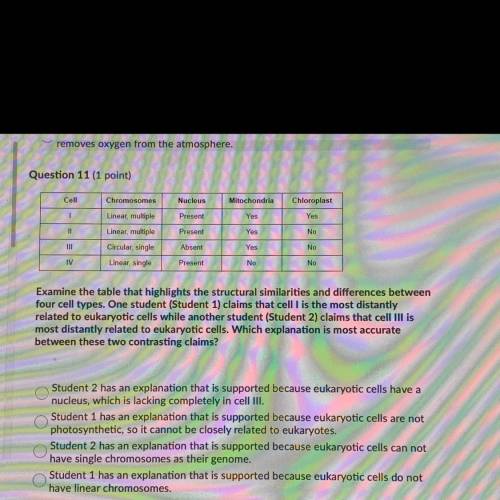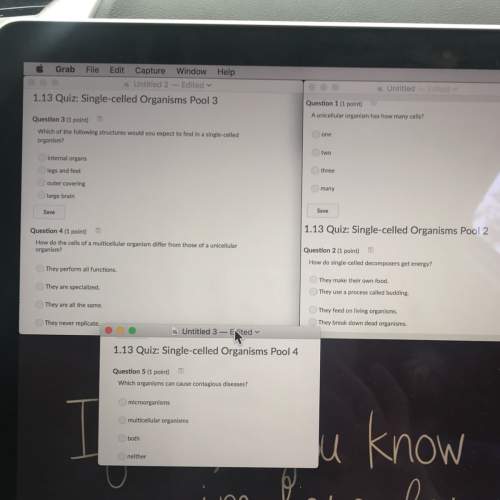
Biology, 24.03.2021 03:30 dtrdtrdtrdtrdrt1325
Examine the table that highlights the structural similarities and differences between
four cell types. One student (Student 1) claims that cell I is the most distantly
related to eukaryotic cells while another student (Student 2) claims that cell III is
most distantly related to eukaryotic cells. Which explanation is most accurate
between these two contrasting claims?
Student 2 has an explanation that is supported because eukaryotic cells have a
nucleus, which is lacking completely in cell III.
Student 1 has an explanation that is supported because eukaryotic cells are not
photosynthetic, so it cannot be closely related to eukaryotes.
Student 2 has an explanation that is supported because eukaryotic cells can not
have single chromosomes as their genome.
Student 1 has an explanation that is supported because eukaryotic cells do not
have linear chromosomes.


Answers: 3


Other questions on the subject: Biology

Biology, 21.06.2019 22:00, corrineikerd
Protein synthesis actually begins in the nucleus when transcribes a single gene on the dna molecule is copied. the process of copying this gene is called this copy is known as and contains the protein building instructions. this copy is sent out into the cytoplasm to the part of the cell known as the the of the ribosome will join together to form a functional ribosome when they attach to the mrna. as the mrna moves through the ribosome, the message is read by transfer rna brings the correct back to the ribosome. the amino acids are placed in the correct order and are hitched together by
Answers: 3

Biology, 22.06.2019 01:30, bbqchicken243
What type of competition exsist between two species. turtles and fish
Answers: 1


Biology, 22.06.2019 03:00, sophiav9780
Where does all the water go? according to the environmental protection agency (epa), in a typical wetland environment, 39% of the water is outflow; 46% is seepage; 7% evaporates; and 8% remains as water volume in the ecosystem (reference: united states environmental protection agency case studies report 832-r-93-005). chloride compounds as residuals from residential areas are a problem for wetlands. suppose that in a particular wetland environment the following concentrations (mg/l) of chloride compounds were found: outflow, 60.4; seepage, 73.7; remaining due to evaporation, 26.4; in the water volume, 46.8. (a) compute the weighted average of chlorine compound concentration (mg/l) for this ecological system. (round your answer to one decimal place.) mg/l (b) suppose the epa has established an average chlorine compound concentration target of no more than 58 mg/l. does this wetlands system meet the target standard for chlorine compound concentration? yes. the average chlorine compound concentration (mg/l) is too high. yes. the average chlorine compound concentration (mg/l) is lower than the target. no. the average chlorine compound concentration (mg/l) is lower than the target. no. the average chlorine compound concentration (mg/l) is too high.
Answers: 3
You know the right answer?
Examine the table that highlights the structural similarities and differences between
four cell typ...
Questions in other subjects:



Mathematics, 24.07.2019 09:30






Chemistry, 24.07.2019 09:30

Chemistry, 24.07.2019 09:30




